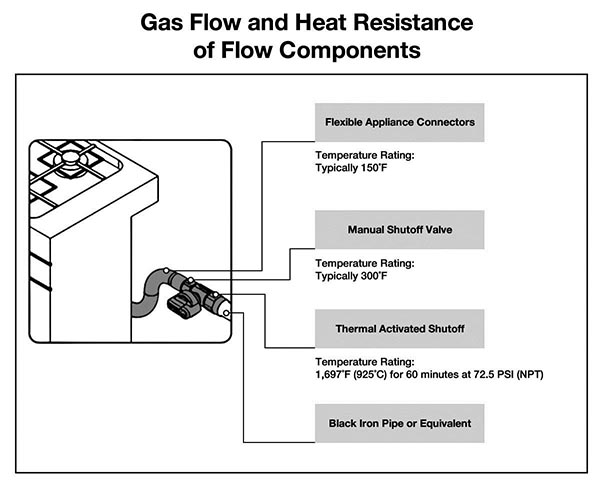Fire Station Cutbacks Create Greater Need for Fire Prevention and Gas Safety Building Codes
Recent cutbacks to fire department budgets across the country have increased the importance of modern household and commercial fire prevention techniques and devices. A 2012 code proposed for the International Fuel and Gas Codes sought to provide inexpensive, automatic thermal gas shutoffs for gas appliances, reports TECO Americas. These thermal shutoff devices stop the flow of natural, propane, and butane gases in the event of a fire, decreasing the likelihood of death, injury, or property damage.
The 2008 recession and subsequent weak economy impaired many communities’ abilities to provide basic civil services to their residents. State and municipal budget cuts have forced fire departments and emergency medical services (EMS) to drastically cut staff and engines, institute “rolling brownouts,” and permanently shut down stations. These cuts led to longer response times, and, in too many cases, have proven deadly. According to a report previously posted on the US Homeland Security’s US Fire Administration website, the United States has one of the highest fire death rates per capita among Western Nations.
Elizabeth, NJ, home to 125,000 city residents, industrial warehouses, refineries, and one of the busiest ports in the world – the Port Newark-Elizabeth Marine Terminal – has seen its fire department dwindle by 26%, from 269 uniformed firefighters in 2005 to 200 in 2012. In a February, 2011 NJ Senate Committee Hearing, Lathey Wirkus, Elizabeth’s Deputy Fire Chief, testified that “the current reductions … will [cause] increased life-loss – not only with civilians but with firefighters.” (1)
These drastic are not unique to Elizabeth. A quick glance at only a few of the nation’s fire station reductions and closures include:
- San Jose, CA lets 49 firefighters go in 2010
- Lowell, Mass lost 23 firefighter positions in 2010
- Philadelphia, PA instituted a “rolling brownout system” in 2010, temporarily closing three fire companies each shift around the city
- San Diego, CA instituted a “rolling brownout” system in 2010, halving the operational staff at 13 of the city’s 47 stations
- Closure of the Hesperia Fire House in San Bernardino County, CA
- East Point City, GA closed two fire stations
- Baltimore, MD instituted rotating closures of fire stations
Fire Prevention
In order to provide better fire prevention and safety standards, municipal and state building codes continue to evolve. The International Code Council (ICC) was established in 1994 as a non-profit organization dedicated to developing a single set of comprehensive and coordinated national model construction codes. Since, all fifty states and the District of Columbia have adopted the ICC codes.
The ICC updated its International Fuel Gas Codes (IFGC) in 2012. The IFGC regulates fuel gas distribution piping, gas-fired appliance installations, and gas-fired appliance venting. The IFGC protect public health and safety for all building systems that use fuel gas for the design, installation and inspection of fuel gas systems by providing minimum standard safeguards for people at homes, schools, and workplaces. The IFGC is the most widely applied Fuel Gas Code in the United States, and it is updated every three years to include the latest advances in technology and safest mechanical practices.
Gas Appliance Safety
 Most homeowners are familiar with the IFGC-required manual gas shut-off valves for gas appliances. These valves allow gas dryers, ranges, and gas furnaces to be replaced safely when new appliances are installed. Many European countries such as Germany, Austria, and Switzerland also require that these manual gas shut-offs be equipped with thermal activated gas shutoffs, which automatically stop the flow of gas when a fire raises the ambient temperature to 212º F.
Most homeowners are familiar with the IFGC-required manual gas shut-off valves for gas appliances. These valves allow gas dryers, ranges, and gas furnaces to be replaced safely when new appliances are installed. Many European countries such as Germany, Austria, and Switzerland also require that these manual gas shut-offs be equipped with thermal activated gas shutoffs, which automatically stop the flow of gas when a fire raises the ambient temperature to 212º F.
The Case for Better Gas Appliance Safety
Building occupants have a false sense of security regarding gas appliances. Occupants assume they have the protection of thermal activated gas shut-offs, when in reality the manual valves have to be physically shut off to prevent gas release. A thermal activated shut-off provides passive gas and fire safety, and does not depend on a homeowner or facility manager to locate and manipulate a manual valve. Thermal activated gas shut-offs stop the flow of gas to the appliance prior to connection failure due to fire.
Thermal Activated Gas Shutoffs
Although the current provisions of the codes require manual shut-off valves for all gas appliances for appliance maintenance or replacements, current codes fail to address the life safety and property protection offered by thermal activated shutoffs. Thermally activated gas shutoffs improve the safety of gas appliances at minimal additional expense. The benefits of improved safety at minimal cost come from the characteristics of thermal activated gas shutoffs:
- They prevent fire escalation, protecting life and property
- They do not incur any additional labor costs when installed
- When activated, the thermal gas shutoffs isolate the flexible gas connection – which in many cases is only rated to 150°F
- A valve can serve as a dual-purpose manual shut-off and thermal activated valve allowing only one installation at each gas appliance
Thermal activated gas shutoffs stop the flow of gas regardless whether the fire fighter’s or emergency responders experience delays in getting to fires or if they cannot stop the gas service at the meter. Note that delays to reach fires occurred 43,222 times during the five-year period from 2005-2009 in the U.S.
When manual gas shut-off valves are combined with passive, thermal activated shut-offs, occupants and first responders greatly reduce risk to their lives. And they are much better protected from personal harm and property damage. Automatic thermal gas shutoffs greatly reduce the amount of gas released to the atmosphere when fire occurs. Uncontrolled gas leaks pose a significant hazard to firefighters, emergency responders, and the public.
When fire fighters reach a fire, the gas shut-off valve may not be easily found, preventing gas from being turned off to the entire dwelling or building. Also, a gas shut-off valve inside the dwelling or building may be inaccessible to the fire fighters. Automatic gas shut-offs stop gas flow from exacerbating structure fires even in these circumstances.
“We too often take prevention and fire safety for granted – until the unexpected happens, which makes us recognize simple devices such as thermal activated gas shutoffs can save lives and property,” observes Wally Armstrong, a partner at Liberty Sales and Distribution, with over 25 years of gas industry experience.
(1) http://larouchepac.com/node/17451
About TECO Americas
TECO Americas provides gas safety products for residential and industrial appliances and buildings. TECO Americas sells high quality fire safety products for natural, propane and butane gases. The FireBag®, TECO Americas’ leading product, is an automatic, thermally activated gas shutoff device. The FireBag® prevents the free flow of gas during fires, substantially reducing risk to both lives and property. The FireBag®’s thermally activated gas shutoff device offers significantly stronger protection from property damage and personal injury to residents, workers and fire fighters than manual shutoffs alone.
Resources
Contact Us Today!
All information is confidential and sent directly to a TECO Americas representative.
TECO® Americas, LLC
263 Cox Street Roselle, NJ 07203
inquiry@tecoamericas.com
Phone: 908-488-0909
https://tecoamericas.com



